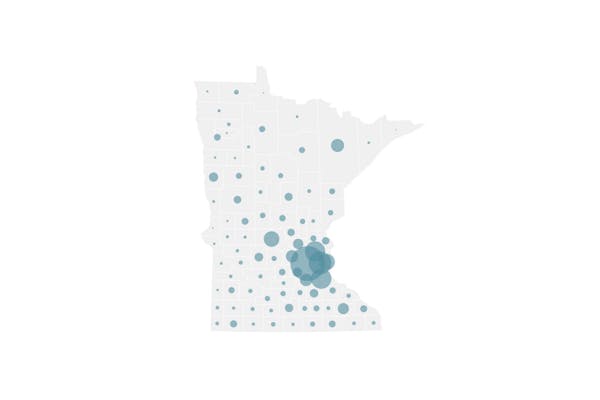Gov. Tim Walz is planning to announce Wednesday that he will loosen restrictions on bars and restaurants in Minnesota, which emerged from the holidays with hopeful signs of declining COVID-19 hospitalizations and rising vaccinations.
Fitness classes, swimming pools and amateur sports practices resumed on Monday, but Walz's current order keeps indoor service at bars and restaurants closed through Jan. 11. Whether they will be allowed to reopen at partial or full capacity was unclear.
Walz's decision comes amid a substantial decline in the number of COVID-19 patients hospitalized in Minnesota — from 1,864 patients on Nov. 29 to 810 on Jan. 3. The positivity rate of diagnostic testing also dropped from 15.5% in the seven days ending Nov. 10 to 4.7% on Dec. 24 — the first time since Sept. 17 that the key measure of pandemic activity had dropped below the state caution threshold of 5%.
However, the rate rose to 5.8% on Dec. 26, and health officials warned that viral transmission over the holidays could push infection numbers back up again.
Health Commissioner Jan Malcolm said there were "hopeful signs on the COVID front" but that data produced during the holidays was somewhat unreliable and that Minnesotans need to remain on guard against infection with the novel coronavirus that causes COVID-19.
"Our COVID-19 situation in the state has improved," Malcolm said, "but unfortunately a year now into this global pandemic, we know that improvement is tenuous. We've seen it from our own experience and from other states and even nations. If we let our guard down, COVID-19 finds a way to surge back."
Minnesota has received 297,350 doses of the Pfizer and Moderna vaccines for COVID-19, and officials reported that 78,402 first doses of the two-dose vaccines had been administered to its high-priority group of health care workers and residents of long-term care facilities.
The state has distributed enough vaccine for the first wave of health care workers — mostly those working in COVID-19 units and emergency departments — and is on track to provide first doses to everyone in this priority group by month's end, said Kris Ehresmann, state infectious disease director.
Vaccination of the next priority group, including workers in critical industries and people 75 and older, should start in late January or early February.
Ehresmann disagreed with criticisms of a slow rollout, noting that Minnesota ranks 16th among states for its per capita rate of vaccination.
"This is a new step in our journey to the end of this pandemic," she said.
Minnesota's total does not include doses received by federal agencies in the state, such as tribal hospitals and the Minneapolis VA Medical Center. It does include 82,500 doses earmarked for distribution to long-term care residents by pharmacy chains CVS, Walgreens and Thrifty White.
The state is scheduled to receive another 32,700 Moderna initial doses and 33,150 Pfizer initial doses this week. The federal government has guaranteed that second doses, administered three to four weeks later, will be available to send later on.
Staying vigilant
People 75 and older have been at elevated risk of severe illnesses throughout the pandemic and make up 73% of the 5,443 confirmed COVID-19 deaths in the state — including 12 of the 13 newly reported deaths on Monday.
The Minnesota Department of Health on Monday reported another 3,148 diagnosed infections, the highest single-day total since Dec. 13. But that was inflated by the belated reporting of 667 test results from earlier in the year.
The state has reported a total of 423,688 diagnosed infections, including 405,556 people who have recovered to the point that they are no longer considered infection risks to others. Some public health experts have estimated that one-fifth of Minnesota's population — more than 1 million people — has already been infected, when including those who had mild or no symptoms and never sought testing.
Pandemic totals have declined sharply over the past month in Minnesota, even as a wave of COVID-19 that first emerged this fall in the Upper Midwest has radiated to the rest of the country. Minnesota had the nation's highest new infection rate in the week ending Dec. 4, but dropped to 43rd in the week ending Dec. 25, according to the White House Coronavirus Task Force.
Malcolm credited the state's progress to the commitment of Minnesotans to mask-wearing, social distancing and avoiding large gatherings.
She added that Minnesota saw a lower peak of infections and deaths than its border states, and a more rapid decline last month. She attributed that partly to Walz's order in late November that closed indoor service at bars and restaurants and restricted group gatherings.
"It's going to take many months to vaccinate everybody in our communities," Malcolm said, "and we need to stay vigilant, as we have been, to limit the impact of severe illness and death — avoidable severe illness and death — from this virus."
Critics have noted that the decline in cases in Minnesota was already taking place before the November order, which has been especially economically painful for bars and restaurants and prompted a handful of them to defy the order and remain open. A group of 27 hospitality businesses filed suit Monday, seeking to reopen and end COVID-19 restrictions that they argue contributed to the closure of 94 restaurants in 2020.
The governor's "loosening of restrictions on indoor dining and other settings" will be announced in a live public address at 2 p.m. Wednesday, according to a statement from his office.
Jeremy Olson • 612-673-7744
Carolyn Parnell, 'trailblazer' who served as Minnesota's first IT commissioner, dies


